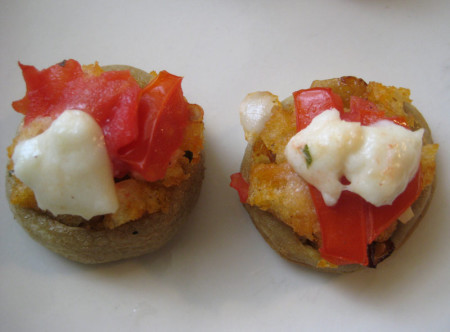
This has been quite a season for puffballs—both large and small—in the Colorado high country. Though the season for giant puffballs is upon us, I wanted to first share a preparation we’ve been enjoying with small puffballs, which are still out there fruiting like crazy too. I like to call it “stuffballs.”
For the stuffballs I’ve been using puffballs of the genus Lycoperdon. Up here we have gem-studded puffballs (Lycoperdon perlatum), which when young and fresh have what Vera Stucky Evenson (1997) describes as “conelike spines” covering the top that can be rubbed off. The puffballs are “almost spherical with a tapered base,” she writes, adding that they can be “abruptly tapered at the base.” In my experience the tapered bases can come together gradually, or seem like miniature fat stems. I often find L. perlatum growing deep in conifer forests, in soil on the forest floor.
We also have the related pear-shaped puffballs (Lycoperdon pyriforme, per Evenson), which are pear-shaped, as the name suggests—also roughly spherical with an elongated base. Michael Kuo at MushroomExpert.com writes that L. pyriforme is a very recent synonym for Morganella pyriformis, and that the pear-shaped puffballs are one of the few puffballs that grow on wood (or lignin-rich soil, Arora, 1984). The mushroom’s surface starts out smooth, Evenson writes, developing coarse granules later so as to appear rough.
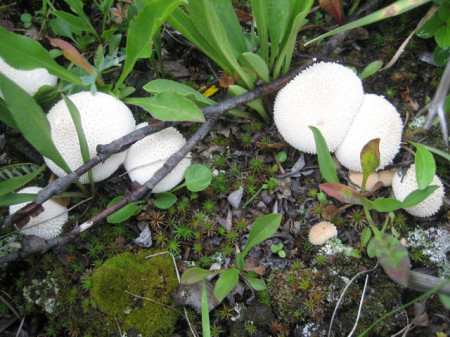
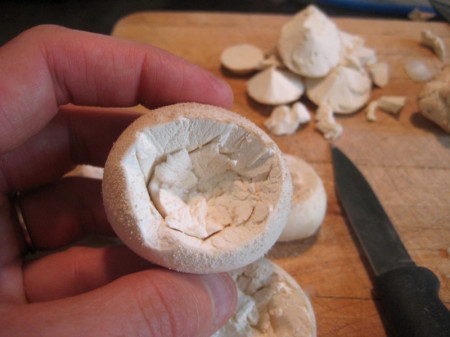
In neither L. pyriforme or L. perlatum is there a separate stem per se, but they can appear that way. Both are widely distributed throughout North America, though I am only scratching the surface of the many Lycoperdons—not to mention other genera of puffballs—here. When you slice either of these (fresh) Lycoperdons vertically, the flesh is even and white throughout, without even a suggestion of an underdeveloped cap in cross section—if so, it could be an Amanita button, and some species are deadly. (Up here in the Colorado high country, the uncomfortably-psychotropic-but-not-known-to-be-deadly Amanita muscaria buttons look a lot like warty giant puffball babies). There also should be no yellow or reddish staining under the peridium (spore case wall, or skin) in cross-section.
Slicing a suspected puffball vertically is also a way to test that it’s white and fresh (overripe, inedible puffballs turn yellowish and then darker and later puff out dark spores) and it is not an earthball (Schleroderma sp.), which can be black or dark purple inside except in very young specimens.
For Advanced Puffball Users
Now a “stuffball,” if you will, is just what it sounds like—a stuffed puffball. I thought it would be fun to hollow out puffballs like a bread bowl, and fill them with stuff to bake in the oven. (I swear I spent an entire week doing this.) Because I was using the small Lycoperdons—the largest ones were the size of a ping-pong ball and many were half that big—the stuffballs made for a good hors d’oeuvre rather than a main course.
But for the stuffball recipe, you have to hollow out the puffballs from the top, so you skip the cut-in-half step. Therefore I’d recommend this preparation only after you’ve spent a good amount of time with puffballs—so much so that you can verily tell the difference between them and poisonous lookalikes, if any for your region. (A good regional guide is a great place to start.) Also, for success with this preparation it’s good to have a sense of whether a puffball is likely to be fresh enough to eat by the firmness of its skin when you poke it in the exterior, or its color, or other manner of assessment that does not involve slicing it. (It’s still possible to see if it’s on its way out when you cut out the bowl, however.)
David Arora writes in Mushrooms Demystified (1984) that even the slightest hint of off-color means the puffball should be discarded rather than consumed.
There’s a World of Stuffing in Leftovers
But for confident puffball users, here’s what you do: Prepare the puffballs by slicing the base a little if needed so the puffball sits flat on a cutting board. Then cut a top piece out like you re cutting the top out of a miniature bread bowl. Paint olive oil all over the hollowed-out puffballs, inside and out, and bake in a 350-degree oven for 10 minutes until golden brown and soft. Then stuff ‘em with stuffing of some sort and set them back in the oven at the same temperature for another 10 minutes. (I did this at 10,000 feet, so times may vary. Also, I used the toaster oven).
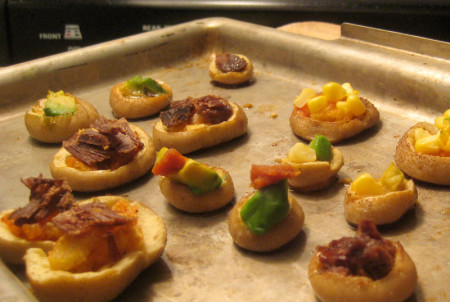
My personal stuffing adventures involved gathering a bunch of leftover ingredients and sauces together in small bowls—one time I did various combinations of tomatoes, stuffing, queso fresco, cutthroat trout, sauteed puffball bits, and antelope liver pate; another time I did shreds of antelope roast, avocado chopped into small pieces, a little bit of leftover onion-and-breadcrumb stuffing, raw corn kernels cut from an ear of corn, red miso, sugared soy sauce, and Cholula hot sauce.
Among the first round, I very much enjoyed the antelope liver pate stuffballs, though Gregg found them quite rich. The stuffing with tomato and queso fresco was nice too.
In the second and larger round, I made half the stuffballs pan-Asian flavored, and half Mexican-style. One of the standouts had antelope meat, avocado, red miso, and sweet soy—Gregg and I both agreed it was delicious. The miso-and-avocado stuffball was good too; Gregg said the miso worked well with the puffballs’ strong flavor. Beyond those I had various takes on the same concept—antelope in sweet soy, avocado in sweet soy, corn and avocado in sweet soy, and so forth.
A few plain stuffing-and-meat stuffballs did well for cleansing the palate of the soy-kissed mushrooms before moving onto those dressed with Cholula.
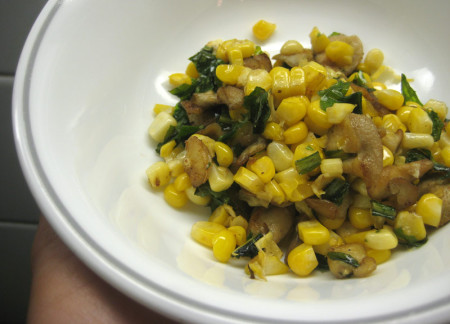
Then on the Mexican side of things, the most popular stuffball was corn kernels drizzled with Cholula, and I also made some with avocado, corn, and hot sauce.
The stuffballs were a bit of work, but they sure were fun. Only one problem remained: what to do with the “caps” I’d carved out of the puffballs.
Hot Corn & Puffball Sauté
I used the leftover cutout puffball chunks to make a veggie dish served after the stuffballs. This involved sautéing the puffball pieces in an oil/butter mix at medium heat until golden brown and soft throughout. Then I added raw kernels cut from an ear of fresh corn along with handful of finely chopped dandelions and sautéed briefly, until the dandelions wilted. The Hot Corn & Puffball Sauté came out surprisingly good! I think the sweet, farm-fresh corn and strong fall dandelion greens worked wonders to complement the puffballs’ strong flavor.
More Recipe Ideas
I’m certainly not the first person to think of stuffing puffballs, so here are some links to what other folks have been doing:
- http://foragerchef.com/cheese-stuffed-puffball-mushrooms-with-ramp-ketchup – This not only sounds divine, but also allows you to slice the puffballs in half, confirming ID, as part of the preparation process.
- http://www.wildmushroomrecipes.org/recipes/stuffed-puffballs – Another take on stuffed puffballs that uses softball-sized puffies.

They really are adorable, Mrs. and Mr. Puffball 🙂